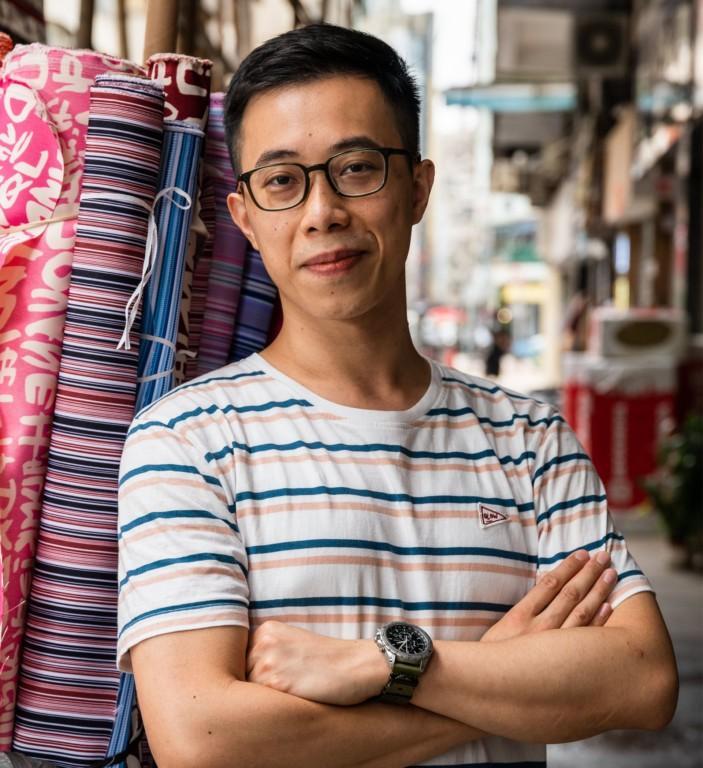
Will conscious consumers save the world?
16.09.2021
Sustainability is talked about everywhere nowadays. The problem is that sustainability does not really mean anything. At the same time we expect consumers to change the world. But how can a Chinese consumer use their voice? Why is environmental sustainability more interesting to a Western shopper than the conditions of factory workers?
Text: Heidi Nummi
Pictures: Gary Jones, Taras Dziubko & Eeva Anundi
Translation: Helena Lehti
A sign of the times is that democracy is in crisis, but consumers are still expected to change the world.
According to a recent study, the sale of second hand clothes will surpass fast fashion in the United States by 2030. A survey from 2019 shows that almost half of Chinese consumers would like to use environmentally friendly clothes.
Winds of change, signs of hope. You get the idea that the world is truly changing through shopping.
But the winds do not reach where factory workers still work long days with minimal pay. These are definitely mixed signals. One clear issue is that those who need the change the most are not the ones who keep sending signals to buy. They are the ones who make all of the things that we others buy.
Consumers have a voice, they say, but what if you do not have the opportunity to consume? Do you not then have a voice?
voice of the Factory workers is not heard
There is a problem in the dominant conversation culture, says sustainability expert Maija Lumme from Pro Ethical Trade Finland (Eetti). The whole basis for the discussion continues to be how we can buy better.
“We are too self-absorbed. We live in an individualistic time of social media and everyone wants to know what they can do. But instead of this we should look up and listen to those people who have the most to say on the topic.”
People in factories are not to be pitied, Lumme reminds us. They are the best experts on the topic. But still we hear their voices much too rarely.
Everyone knows the traditional cheap labour countries in the textile industry such as Bangladesh and Myanmar. But nowadays we do not have to look far, because new low-cost countries can be found in Europe.
Oksana Dutchak is an activist and independent researcher who fights for people in factories in Ukraine. She was a child when the Soviet Union collapsed.
“Clothes were a luxury. As a child, I hated going to the shops because I saw everything that my family could not afford. If someone got a new piece of clothing, that was very special,” Dutchak reminisces.
As a teenager Dutchak thought that the ability to buy new clothes was an achievement that was worth striving for. At university she found out for the first time that clothes were also made in Ukraine, in her hometown – and she found out about the conditions they were made in.
“I am not a fashion blogger who had an environmental awakening. Before I even had the money to buy new clothes, I realised that I do not want to do that.”
Buying second hand clothes is common in Ukraine. Dutchak also shops second hand; for her, it is a lifestyle. But most Ukrainians buy second hand clothes because they have to. Most second hand products are brought from Western Europe.
“Here this is not due to a sustainability trend, but because of poverty.”
In past years, Dutchak has been doing research on the conditions of Ukrainian factory workers. It has not been easy, because she must speak to the workers in secret. Dutchak has spoken to dozens of people. Many of them have the same wish: that they could one day use the clothes that they make for a living.
“For them this is a distant dream. They can afford these clothes only when Western consumers no longer want them.”
environmental sustainability is useless without social sustainability
Sustainability is talked about a lot nowadays, but far too often this only means environmental sustainability, Dutchak explains. Environmental sustainability cannot however exist without social sustainability.
“As long as a person is poor, it is useless to try to sell them sustainable thinking.”
How much does a Ukrainian factory worker earn? The minimum wage for a garment worker is 80 euros a month. Ukraine is a cheap country, but not that cheap. The money is simply not enough for living.
Especially in the summer there are a lot of orders. During these months, people work 12-hour days, six days a week. At the same time, the conditions in the factory are at their worst. The temperature rises to 40 degrees and there is no air conditioning, and often ventilation is also lacking. High blood pressure, fainting and nausea are all common symptoms in the factories.
A minimum wage is not the same as a living wage, Dutchak reminds us.
“People work excessive amounts of overtime simply because they need to make more money. This cannot be called voluntary overtime because they have been forced into this situation.”
problematic situation of female employees
The impact of gender is also clear. In addition to material poverty, we can also speak of temporal poverty.
“In Ukraine, women still do all of the housework and single mothers are in the worst situation. Often they also need to have side jobs. They also have gardens where they grow their own food. All of this takes up a lot of time.”
So they have no own time and no social life. And no money. To top all this off, they are chronically sleep deprived.
You can complain – but at your own risk. It is likely that if you complain, you are transferred to a lower-level task, which means that the salary may even be halved. This is a common way to punish workers in a country where you cannot fire people, but transferring to other tasks is possible.
“Usually this happens when an employee begins to demand rights or talks about faults. The threat of a lower salary is an efficient way to silence workers and control them,” Dutchak explains.

The new low-cost countries in the textile industry are almost next door. Oksana Dutchak fights for factory workers in Ukraine. Many of them only make 80 euros a month.
Absolute poverty is a reality for Garment workers
In 1995 the United Nations presented the definition that people in absolute poverty are the ones who try to live off of two dollars a day. After this there have been many strides to alleviate poverty, but the situation remains that most garment workers live in absolute poverty.
The worst situation is in Ethiopia where workers make one dollar a day.
Poverty is a multifaceted phenomenon, says Johnson Yeung who follows the situation from Hong Kong. The problems in the garment industry are much the same everywhere, but the political situation brings its own added features. Yeung knows this well, because he is not only the coordinator for the Clean Clothes Campaign in East Asia, but also a democracy activist.
Poverty largely means that you cannot take control of your own life and you cannot affect things. The power of the masses does not arise when you have been shoved into the margins.
“These people have it so tough that they cannot participate in the battle for the climate, even though this directly affects them. There is no hope that they could promote environmental protection in factories or monitor their carbon footprint,” Yeung says.
china suppresses protesting
Opportunities for negotiation are also reduced by the political situation. In Hong Kong, the situation has become more difficult each year.
“Here we have no power of the masses. We do not even have a union movement.”
In Mainland China, the situation is even worse. The implementation of labour laws is not monitored and all independent trade unions are illegal. Masses are put down immediately. This is worrying, because up to 40 percent of all clothes in the world come from China.
“People cannot fight this, because the government ends all strikes immediately,” Yeung says.
The situation is made no better by the fact that in China – and increasingly Hong Kong – the attitude towards international human rights is indifferent or even hostile.
“People get in trouble for trying to promote human rights. People are arrested and they have to go to jail and they are never heard of again.”
The whole civil society is weak and thus companies have no pressure to change their ways. There is enough purchasing power in China – every fifth person in the world is Chinese. But what sort of voice does a consumer have who does not politically exist and who has no freedom of association or right to make a noise?
That voice is very weak, Yeung says.
complex production chains allow for human rights violations
Sweat shops are nothing compared to what is happening in China’s Xinjian. The Uyghur minority in Xinjiang has been subject to severe persecution. Uyghurs have been forced to work in garment factories in conditions resembling slavery. Cases of torture have also been reported.
“The powerlessness of Chinese consumers is evident here. They cannot affect what is happening in their own home country,” says Yeung.
Last year it became known that the cotton used in the clothes of many Western fashion brands comes from Xinjiang. A coalition of over 400 agents has later tried to get companies to stop using cotton from that area.
The response from companies has been that they do not actually know where their cotton comes from.
The core of the issue is that the current production chains are much too complex. It is difficult for companies to act responsibly when the scale is so large. There are hundreds of subcontractors and that is why companies need to trust certifications and other responsibility systems.
Consumers also face a tough choice because the Made in tag does not tell us much. It does not tell us where the raw material has come from or where the fabric has been sewn.
One solution would be that clothes would have a list of contents. If this list would be mandatory, most companies would of course be in trouble.
As the Xinjiang case shows, companies do not know what happens in different stages of their production chains. The more subcontractors there are, the more unclear the information is.
The situation goes completely against the UN’s principles for companies and human rights, Lumme explains.
“Companies have the responsibility to respect human rights. In the current situation, this responsibility is impossible to bear.”
problems are deeply rooted in the global trade system
Everything goes back to the structures of global trade. Companies act in the environment they need to act in. They are responsible to their investors and therefore they need to make a profit. The requirements for their operations are continuous growth and ever-increasing production volume.
Competitiveness can only be kept up by cutting back on costs. In practice there are only two things to cut back on: consideration of the environment and the wellbeing of employees. In these conditions, one strategy is the best: to outsource production into countries without environmental or labour laws – or if these laws exists, corruption ensures that the legislation does not matter.
Now we need massive structural changes, Yeung says.
“Companies have two options. Either they stop their operations entirely or then they abandon the idea that maximising profits is their only goal.”
According to a global study conducted in 2019, almost 70 percent of consumers think that companies have the same social responsibility as governments. There seems to be some type of awakening coming.
A mere awakening is not enough though, says Yeung.
“Though various guidelines are compiled all the time, binding legislation is still very rare.”
Yeung’s greatest fear is that structural changes do not happen in time. The clock is ticking; Hong Kong has just had the hottest May ever measured. But Yeung does not mean only that.
“Workers live in such extreme poverty that their life expectancy is greatly reduced. Their days are truly numbered.”
The same cycle of poverty continues from one generation to the next: poverty is visible already in foetuses, it is branded into children before birth. This has significant impacts on children’s wellbeing and education, on what type of life is possible for them.

“Companies have two options. Either they stop their operations entirely or then they abandon the idea that maximising profits is their only goal,” says Yeung.
Garment industry improving in sustainability
On the other hand, we must remember that the garment industry is significantly more advanced in sustainability than any other field of production. This topic has been discussed a lot in recent years and various factory accidents have gained publicity. Production is much more transparent than for instance in electronics, where discussions on responsibility have barely begun.
The required level for garment companies and their sustainability continues to rise. Nowadays we can be sure that for instance H&M’s factories do not use child labour. The first tier, meaning the factory which produces the finished product for the shop, has been cleaned up nicely according to Lumme.
“The problems have moved to deeper levels. Now that the first tier is more transparent, we should delve deeper.”
Who is responsible and who should we turn to if there are issues in the production chain? At the moment this question is almost impossible to answer. Companies do not often even know where their factories are located, and much less how many people work there and in what types of conditions.
“How can companies set goals for what they should strive for if they do not even know what the situation is at the moment?” Yeung asks.
In problem situations, it is much too easy for companies to avoid blame and say that it is an issue of the factory owner. Employees have no one to turn to. This is especially difficult for those – most often women – who work from home.
structural violence and abuse
Especially women are in the weakest position and gender differences are apparent in the garment industry in many ways. There are 140 million garment workers in the world and 85 percent of these are women.
Gendered violence is prevalent in factories, but this is not the only issue. The situation has been studied in Bangladesh where it has been noted that 70 percent of women are also subject to violence when commuting to work. It is not an exaggeration to say that the whole structure of society is against them.
“Women are preferred as workers, because low-cost labour is found in the countries where gender stereotypes are still strong. Women are considered obedient and flexible, even submissive,” Dutchak explains.
Offers are also on the table: women may be granted pay rises in return for sexual favours.
The situation can also be inspected from the point of view of immaterial rights. The fashion industry does not have these and that is why clothes can be quickly copied – straight from the catwalk to five-euro rags. Lumme suspects that this is because clothes are still considered “women’s business”.
“Imagine if phones were copied in the same way. It would be an immediate scandal, but with clothes nobody cares,” Lumme explains.
In Finland, researcher Heidi Härkönen has shown that fashion law is not considered a serious field of research, but rather a hobby for young (female) lawyers interested in trends and shopping.
One more appropriate example: When free trade deals came to Finland in the 1970’s and 80’s, trade unions were adamant to preserve heavy industry. How about the garment industry? No one really cared about that.
“Making clothes was not considered a real job and this attitude is still evident,” Lumme says.
sugar-coated sustainability
How many of us admit that they go about sustainability matters mostly by gut feelings? Surely many, probably even most. And no wonder. A recent study showed that consumers are confused about what sustainability in fashion even means. The study was conducted in the United States, but the same is likely true elsewhere in the world as well.
We need to talk about greenwashing for a moment. Nowadays there is a lot of it.
“Companies do not directly lie. It is more the case that they let you assume something positive,” Lumme explains.
As an example, in Zalando’s sustainable development collection only 20 percent of the product is recycled polyester. There is no information about the production country nor human rights.
“Sustainability is a huge trend. Companies want to get in on it, but they are going about it however they want and there are no rules or even good manners,” Lumme states.
This is backed up by an EU study where green statements were fact-checked. It turned out that 40 percent of the messages were either misleading or exaggerated.
“At the moment, sustainability does not mean anything,” Lumme concludes.
Companies do not directly lie. It is more the case that they let you assume something positive.
Where is true sustainability: slow fashion? We have not seen that yet.
On the contrary, the growth of online retailing has accelerated the fast fashion markets more than ever. For example the emissions of Zalando’s products have doubled in the past couple of years. The production of clothes is expected to grow even more. The fear is that the cycle will get completely out of hand.
When solutions are sought, we often turn to circular economy. Lumme does not believe that a circular economy would solve the root issue.
“We cannot replace the pace of current consumption just by changing the raw materials. Similarly, we cannot compensate all emissions.”
Second-hand does not fix it all
The praised second hand markets also include significant issues.
In Finland per person, 13 kilos of textile waste is produced in a year. The US is at similar numbers; the number has doubled within the last twenty years. The majority of the waste is burnt because the quality of the clothing has been so poor to begin with that it cannot last another round.
Some clothes never even get used. Yle’s Spotlight programme mapped out the return percentages of online retailers: almost half. One percent of the clothing goes to the bin straight away when they are returned to the online shop.
“A truly responsible company would talk about quality and would offer repair services,” Lumme explains.
More ambition is required, because at the moment corporate responsibility only needs a small effort. It is enough to do more than is legally required, even if it is only the tiniest bit more.
“Responsibility should not mean that we do not do bad things, but that we produce something good for society and do not exploit everything we can,” Lumme clarifies.

Sustainability is a trend that every company wants to get in on. “Greenwashing is visible in how nice things are highlighted, but the core issues and reasons are not addressed,” Maija Lumme explains.
Higher wages, more sustainable industry
At the moment it seems that environmental sustainability is more interesting to Western consumers than the conditions of people in factories. This is a significant pain point.
“I guess it is a case of not being interested in the lives of people far away, even though we appreciate organic materials. It is also easy to think that buying and consuming can continue as long as you do it in a more environmentally friendly way,” Lumme says.
Improving working conditions is usually much more uncomfortable for businesses than making the products a little bit more environmentally friendly.
“Greenwashing is visible here, how nice things are highlighted, but the core issues and reasons are not addressed.”
The message from the field is clear: Workers in factories want to keep their jobs, but not in their current form. If you ask them, the solution is not to add a couple percent of recycled plastic into your yoga leggings. The solution is to pay them a sufficient pay.
As the wages rise, the price of the products will also rise. The cycle will slow down. In other words: the higher the salaries are, the more sustainable the garment industry will become.
We need new innovations of course. New technology and new materials. But this is not enough.
“New materials always create new problems,” Lumme warns us.
Where does recycled polyester come from? What are the environmental impacts of lyocell?
It is clear as day what we should do now, Lumme states. We need to reduce our consumption of clothes and slow down the cycle.
“The idea up until now has been to consume more responsibly. But the only way to consume responsibly is to consume a lot less. Nowadays people already know what is wrong, but there is some type of optimism that makes us think that problems can be solved and we can continue business as usual. We need to take one more step forward.”
Thinking differently
Now it is time to answer the big question: Will the world get better through buying?
Dutchak, Yeung and Lumme all agree: A consumer cannot change the world. But people together can. It is not enough to buy. We should also use our voices.
A more important driver of change than consumer choices and a bad conscience is the power of the masses. When we make some noise together.
“If you are able to support a more responsible company with your money, then of course this is important. But the basis for this discussion cannot be buying and consuming,” Lumme clarifies.
The idea up until now has been to consume more responsibly. But the only way to consume responsibly is to consume a lot less.
Confrontation and labelling companies as big, bad wolves does not necessarily help either.
“Companies cannot solve this alone. We need a radical change in our way of thinking, and that starts with all of us,” Dutchak explains.
This would start off for instance with appreciating clothes more. Clothes should be something special again, something worth repairing and cherishing. This would benefit everyone: Studies have shown time and again that reducing consumption, repairing and a deeper relationship to clothes makes you happier.
This could create a world without sweatshops and with real jobs. No pity would be needed, because everyone would recognise that workers in factories in Asia and Eastern Europe are professionals in their field. If they had the working conditions that people should have, there would be no more fast fashion.
This article was originally published in Maailman kuvalehti 10 August 2021.
—–
This article was translated with the financial support of the European Union. Its contents are the sole responsibility of Pro Ethical Trade Finland and do not necessarily reflect the views of the European Union.


